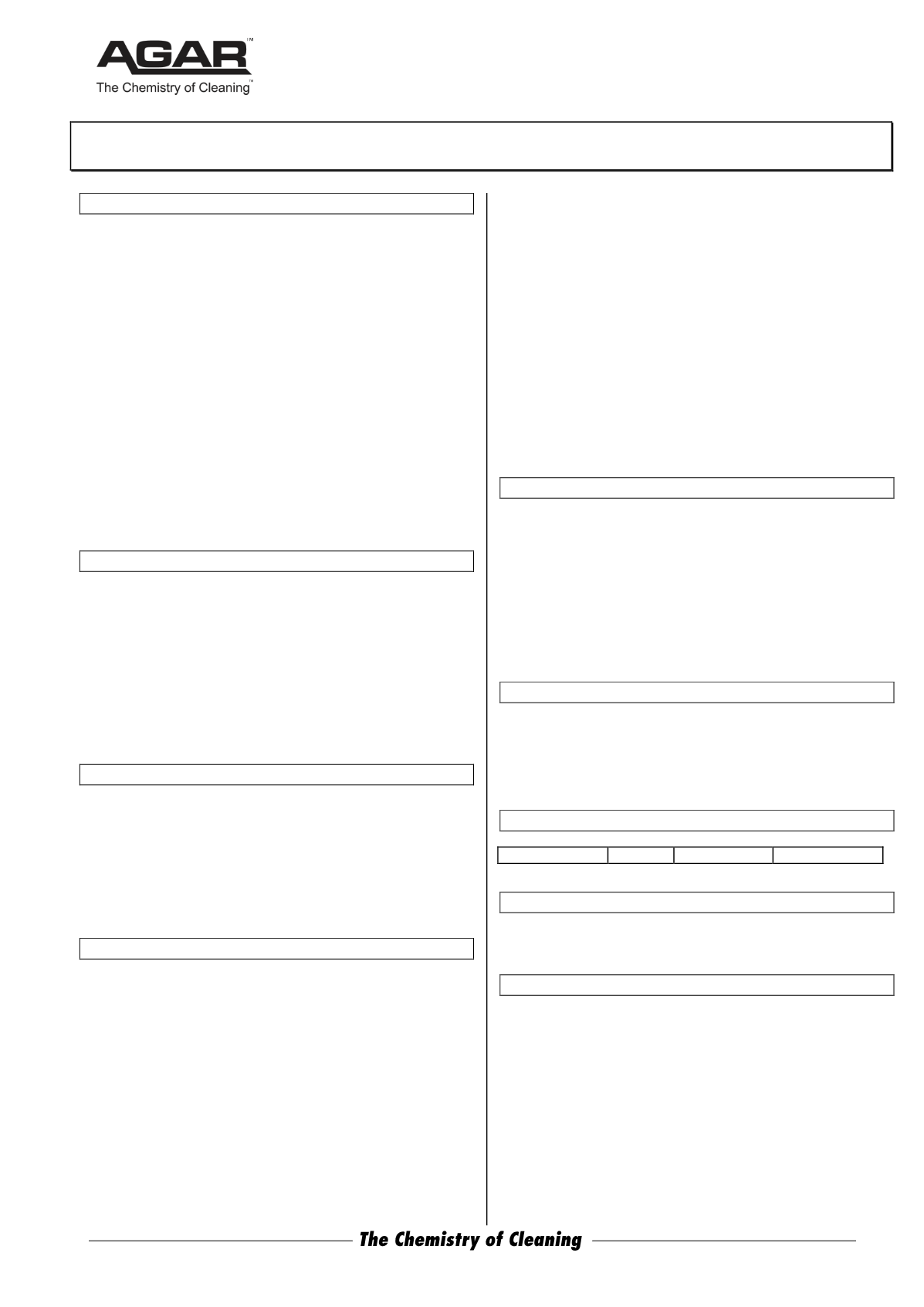

ABN 80 004 726 890 | MADE IN AUSTRALIA
Safety Data Sheet
Issued: November 21, 2012
Page 2 of 3
DISHPOWER
8 EXPOSURE CONTROLS / PERSONAL PROTECTION
Exposure Standards: None assigned for product.
Atmospheric Contaminant Exposure Standard for:
Sodium hydroxide :
CAS No: 1310-73-2 TWA = - ppm, (2 mg/cu.m)
Peak limitation
STEL = -
[Source: Safe Work Australia HSIS- 2012]
Engineering Controls: Mechanical ventilation: not required.
Personal Protection:
Gloves – Impervious natural rubber, butyl rubber, nitrile or
PVC gloves should be worn.
Note: Resistance of glove materials can vary. Evaluate
resistance under conditions of use and maintain PPE
carefully.
Eye protection – Safety glasses should be worn.
Respiratory – Not needed unless dust has been generated.
9 PHYSICAL AND CHEMICAL PROPERTIES
Appearance: White powder with granules.
Odour: Faint odour
pH = 13.2 – 13.7
Vapour Pressure: N/K
Vapour Density: N/K
Boiling Point: > 100
°
C
Freezing Point: < 0
°
C
Solubility in water: Soluble
Specific Gravity : N/K
Evaporation rate: As water
% Volatile by vol: < 10%
10 STABILITY AND REACTIVITY
Stable.
Do not store in aluminium or galvanised containers. Store away
from acids. Dish-Power is a caustic product, which attacks soft
metals
Hazardous polymerization: Will not occur.
11 TOXICOLOGICAL INFORMATION
Health Effects:
Acute -
Considered to be corrosive by all exposure routes. Can kill if
swallowed.
Swallowed: Because of its high alkalinity in the undiluted state,
Dish-Power is corrosive to the gastro-intestinal tract if
swallowed.
Eye: Corrosive. Contamination of the eyes can result in
conjunctivitis and corneal burns and ulceration, which can
result in permanent injury and possible loss of sight.
Skin: Principal route of exposure is usually by skin contact.
Corrosive to the eyes and skin on contact. Skin contact may
cause swelling, redness, blistering, dermatitis or burns with
deep ulceration and gelatinous necrotic areas at the site of
contact. Skin contact may result in little pain, thus care should
be taken to avoid contamination of gloves and boots.
Inhalation: Inhalation risk is low if product is used as directed,
but breathing of dust from the product should be avoided
because of the risk of respiratory irritation.
Health Effects –
Chronic:
None known.
Toxicity Data: Not available for mixture.
For Sodium hydroxide:
oral LD50 (rat) = 2000 mg/kg (sodium hydroxide solid).
oral LDLO Rabbit = 500 mg/kg
Skin (rabbit): Severe Irritant.
Sodium hydroxide has low systemic toxicity.
(Note: this data is from published information. Agar Cleaning
Systems does not carry out animal tests).
12 ECOLOGICAL INFORMATION
Ecotoxicity: data for 100% sodium hydroxide:
Daphnia magna EC50/24hr: 76 mg/L
L.macrochirus LC50/48hr: 99 mg/L
Onchorhynus mykiss LC50/96hr: 45.4 mg/L
Persistence and degradability: -
Mobility: Sodium hydroxide is very mobile in soil and very
soluble in water.
Advice: Prevent entry to natural waterways and drains.
13 DISPOSAL CONSIDERATIONS
For disposal, refer to State Land Waste Management Authority.
Empty containers must be decontaminated. Dish-Power can be
greatly diluted or carefully neutralised with dilute acid and
flushed to drain with copious amounts of water.
14 TRANSPORT INFORMATION
UN No.: 3262
Class: 8 Packg.Group: II Hazchem: 2R
15 REGULATORY INFORMATION
Poisons Schedule Number: Schedule 6.
16 OTHER INFORMATION
AICS Listing:
All components of Dish-Power are listed on the
Australian Inventory of Chemical Substances (AICS).
Date: This SDS issued on November 21, 2012 shall remain valid
for 5 years unless a new SDS is issued in the meantime. Please
contact Agar Cleaning Systems PL to ensure you have the
latest version of this product’s SDS.
Please turn to page 3.


















